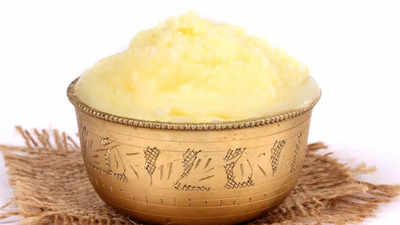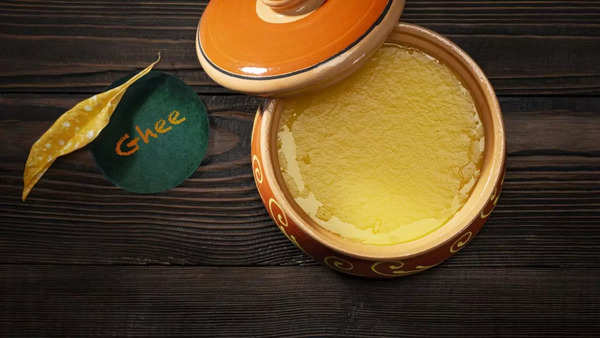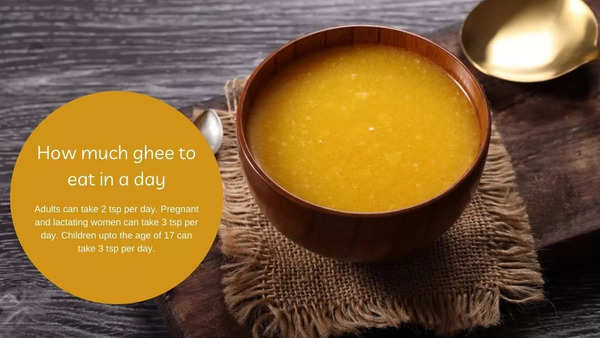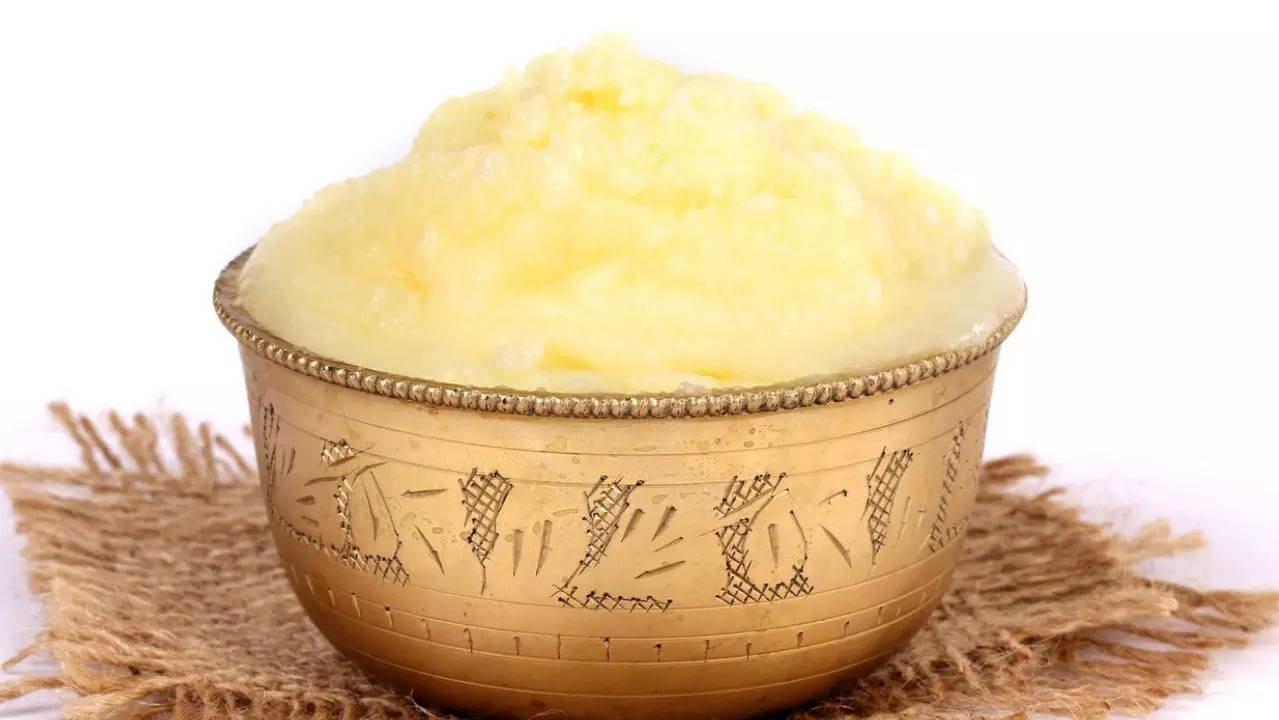Ghee
or clarified butter being a good source of
healthy fats
is recommended in moderation for boosting overall health. Ghee is made by melting butter and separating the solids from the liquid part. While the process to make ghee is the same, both cow ghee and buffalo ghee have their own unique benefits. Buffalo ghee is white in appearance while cow ghee is yellow.
Buffalo ghee is more calorie-dense and suitable for those aiming for weight gain, cow ghee on the other hand is lighter to digest and can help with weight loss.
When it comes to
bone health
, buffalo ghee is preferred as it has more fat content that can nourish the bones well. Cow ghee also has an advantage over buffalo ghee when it comes to
heart health
as it is lower in fat content compared to the latter.
Which ghee is best for you depends on your health goal at the time. Let’s understand and compare health benefits of both varieties of ghee:
What Ayurveda says
In Ayurveda, cow ghee is said to have more medicinal properties compared to buffalo ghee. In fact cow ghee is recognised as one of the most satvic foods, and is said to promote positivity, growth and expansion of consciousness. Ayurveda believes that the milk from cows contains the essence of the positive energies that are present in the pious animals.
Ghee is used as a suitable carrier for many herbs and spices with different medicinal properties, which are to be absorbed and transported to targeted areas of the body. This is why Ayurveda uses ghee in thousands of different herbal preparations for curing various ailments, as per Research Gate.
Shelf life
Buffalo ghee has a higher shelf life due to high amounts of fat. It can be preserved for a longer period ascompared to desi cow ghee.
According to Research Gate, the shelf life of ghee may be 6-8 months, even at ambient temperatures. Although, some studies reported it up to two years. Cow ghee is apparently ore shelf stable than buffalo ghee due to the higher content of natural antioxidants in the former.
Weight management
Weight watchers should stay away from buffalo ghee as it can lead to increase in weight. Cow ghee on the other hand is suitable for weight management with lesser fat content, compared to the other variety.
“Cow ghee contains lesser fat and more conjugated linoleic acid(CLA). CLA boosts metabolism, keeps insulin levels low, and reduces the risk of weight gain,” says Dr. Vishal Khurana, Director, Gastroenterology, Metro Hospital, Faridabad.
Bone health
Buffalo ghee is considered good for promoting bone health due to its fat content. It also helps better with seasonal cold and cough. It is thought to promote bone health and provide long-lasting energy because of its increased fat content, which makes it thicker and richer.
Digestion
People with weak digestion can trust cow ghee better than buffalo ghee as the latter has more fat. Cow ghee is said to have a digestion rate of 96%, which is the best among all fats derived from either plant or animal sources. Due to the presence of medium-chain fatty acids, ghee has a higher nutritional value.
“Cow ghee is believed to be more digestible, which makes it a better option for those with delicate digestive systems,” says Ayurveda doctor Dr Sachin, BAMS, Medical Advisor at Rasayanam Ayurveda.
Cholesterol
Buffalo ghee has more fat percentage than cow ghee and contains saturated fats which could be risky for those watching cholesterol. Cow ghee is a better option for people with high cholesterol, says Shruti K Bhardwaj, Chief Dietician Zydus Hospitals, Ahmedabad.
“Cow ghee contains higher amounts of PUFA (polyunsaturated fatty acids) which are considered good fats. Additionally buffalo ghee has a slightly higher percentage of saturated fatty acids as compared to cow ghee. Consequently, the melting point (m.p.) of cow ghee is lower (35.8°C) than buffalo ghee (38.8°C). Saturated fatty acids are considered bad fats,” says Venus Singh, Coach Lead – Clinical Operations, Sugar Fit.
Nutrition
Both buffalo ghee and cow ghee have unique nutritional profile but the latter has more impressive nutrients. Desi cow ghee contains innumerable minerals, calcium, vitamins, proteins and is a natural antioxidant. This also makes it super beneficial for hair and skin health. Buffalo ghee is rich in essential elements like calcium, magnesium, and phosphorus.
“Cow ghee is a richer source of healthy fat and minerals compared to buffalo ghee. It contains Vitamin D which helps build strong bones. Research and studies have also proved its medicinal benefits. In Ayurveda, cow ghee is used in making various health supplements,” says Dr SP Gupta, Founder Chairman, Kamdhenu Gowdham and Arogya Sansthan.
“Buffalo ghee is loaded with nutrients like magnesium, calcium and Phosphorus whereas cow ghee if full of vitamins A, D and calcium too. Cow ghee has antioxidant and anti-inflammatory properties too,” says Sonia Bakshi, Nutritionist and Founder DtF.
Cow ghee vs buffalo ghee: which is better for children?
Cow ghee can be consumed by people of all age groups. Buffalo ghee should be eaten only by those who are physically more active. This makes desi cow ghee more beneficial for children.
“Cow ghee provides children with more nourishment while reducing obesity and also protecting them from many diseases,” says Dr. Vishal Khurana, Director, Gastroenterology, Metro Hospital, Faridabad.
Sedentary lifestyle vs active lifestyle
For athletes, wrestlers and people who are super-active, buffalo ghee is more suitable. On the other hand, people who lead a sedentary or less active lifestyle should go for cow ghee, as it’s lighter and easier to break down.
“Buffalo ghee is better suited for people who require more energy, such as athletes or people who lead physically demanding lives, but it might not be the best choice for people trying to control their weight or cholesterol,” says Dr Sachin.
Ways to add ghee to your diet
“Buffalo ghee being thicker is the first choice for making heavier curries. Cow ghee with its lighter texture is perfect for making sweets and light dishes,” says Bakshi.
– You can consume ghee with warm water on an empty stomach to give a boost to your gut health apart from enhancing brain function.
– Ghee can keep you full for longer and brushing your roti with a bit of ghee can help satiate hunger.
– You can use ghee for cooking your vegetables as it has a high heat point and can absorb fat-soluble nutrients found in vegetables.
– Add a dollop of ghee on top of your porridge, oatmeal or pancakes to add a burst of nutrients to your daily breakfast.
– You can add a spoonful of ghee in your dals and curries for an irresistible taste.
How much ghee to eat in a day
“Adults can take 2 tsp per day. Pregnant and lactating women can take 3 tsp per day. Children upto the age of 17 can take 3 tsp per day,” suggests Bakshi.
For people across different age groups, cow ghee is a better and safer choice when it comes to heart health, nutrition, digestion and overall well-being. Adding a generous dose of healthy fats to your diet can help reduce bad cholesterol levels and enhance good cholesterol. Eating any kind of ghee in moderation is recommended for preventing heart disease and stroke.
I’m Manas Ranjan Sahoo: Founder of “Webtirety Software”. I’m a Full-time Software Professional and an aspiring entrepreneur, dedicated to growing this platform as large as possible. I love to Write Blogs on Software, Mobile applications, Web Technology, eCommerce, SEO, and about My experience with Life.







